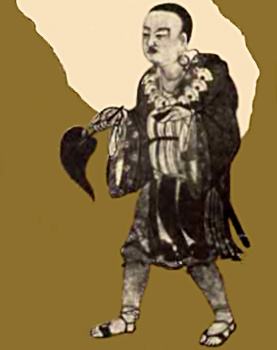|

Champa as seen by Hiuen-tsang
Chen-po (Champa).
This country (Champa.) is about 4000 li in circuit. The capital is backed to the north by the river Ganges, it is about 40 li round. The soil is level and fertile (fat or loamy); it is regularly cultivated and productive; the temperature is mild and warm (moderately hot); the manners of the people simple and honest There are several tens of sangharama, mostly in ruins, with about 200 priests. They follow the teaching of the Little Vehicle.
Twenty Deva temples
There are some twenty Deva temples, which sectaries of every kind frequent.
The capital
The wall of the capital are built of brick, and are several tens of feet high. The foundations of the wall are raised on a lofty embankment, so that by their high escarpment, they can defy stop) the attack of enemies. In old times at the beginning of the kalpa, when things (men and things) first began, they (i.e., people) inhabited dens and caves of the desert. There was no knowledge of dwelling-houses. After this, a Devi (divine woman) descending in consequence of her previous conduct, was located amongst them. As she sported in the streams of the Ganges, she was affected by a spiritual power and conceiving, she brought forth four sons, who divided between them the government of Jambudvipa, Each took possession of a district, founded a capital, built towns and marked out the limits of the frontiers. This was the capital of the country of one of them, and the first of all the cities of Jambudvipa.
A solitary detached rock with Deva temple
To the east of the city 140 or 150 li, on the south of the river Ganges, is a solitary detached rock craggy and steep and surrounded by water. On the top of the peak is a Deva temple; the divine spirits exhibit many miracles (spiritual indication) here. By piercing the rock, houses have been made by leading the streams (through each), there is a continual flow of water. There are wonderful trees (forming) flowering woods; the large rocks and dangerous precipices are the resort of men of wisdom and virtue; those who go there to see the place tare reluctant to return. In the midst of the desert wilds, that form the southern boundary of the Country are wild elephants and savage beasts that roam in herds.
From this country going eastwards 400 li or so, we come to the kingdom of Kie-chn-hoh-khi-lo (Kajughira).
KIE-CHU-HOH-KHI-LO (Kajughira or Kajinaghar).
This kingdom is about 2000 li or so in circuits. The soil is level and loamy; it is regularly cultivated, and produces abundant crops; the temperature is warm; the people are simple in their habits. They greatly esteem men of high talent, and honour learning and the arts.
Six or seven sangharamas
There are six or seven sangharamas with about 300 priests; and there are some ten Deva temples frequented by sectaries of all sorts. During the last few centuries the royal line has died out, and the country has been ruled by a neighbouring state, so that the towns are desolate, and most of the people are found scattered in villages and hamlets.
Harshavardhana’s temporary residence
On this account, Shiladitya-raja, when roaming through Eastern India, built a palace in this place, in which he arranged the affairs of his different states. It was built of branches and boughs for a temporary residence, and burnt on his departure. On the southern frontiers of the country are many wild elephants.
A high and large tower made of bricks
On the northern frontiers, not far from the Ganges River, is a high and large tower made of bricks and stone.
Its foundation, wide and lofty, is ornamented with rare sculptures. On the four faces of the tower are sculptured figures of the saints, Devas, and Buddhas in separate compartments.
Going from this country eastward, and crossing the Ganges, after about 6oo li we come to the kingdom of Pun-na-fa-tan-na (Pundravarddhana).
|
